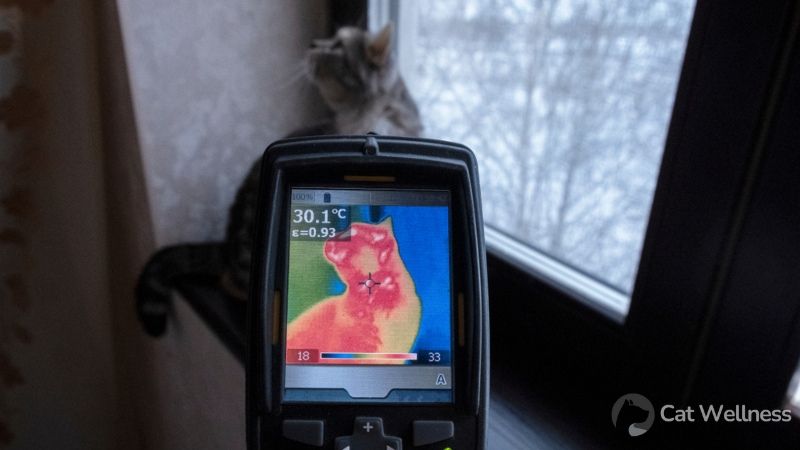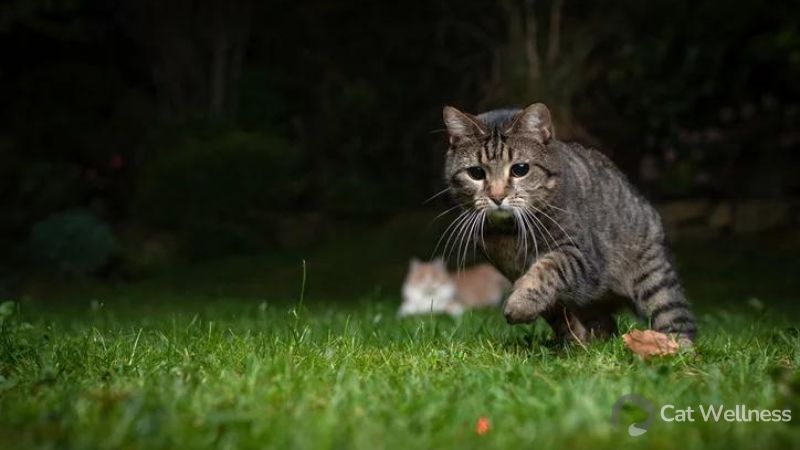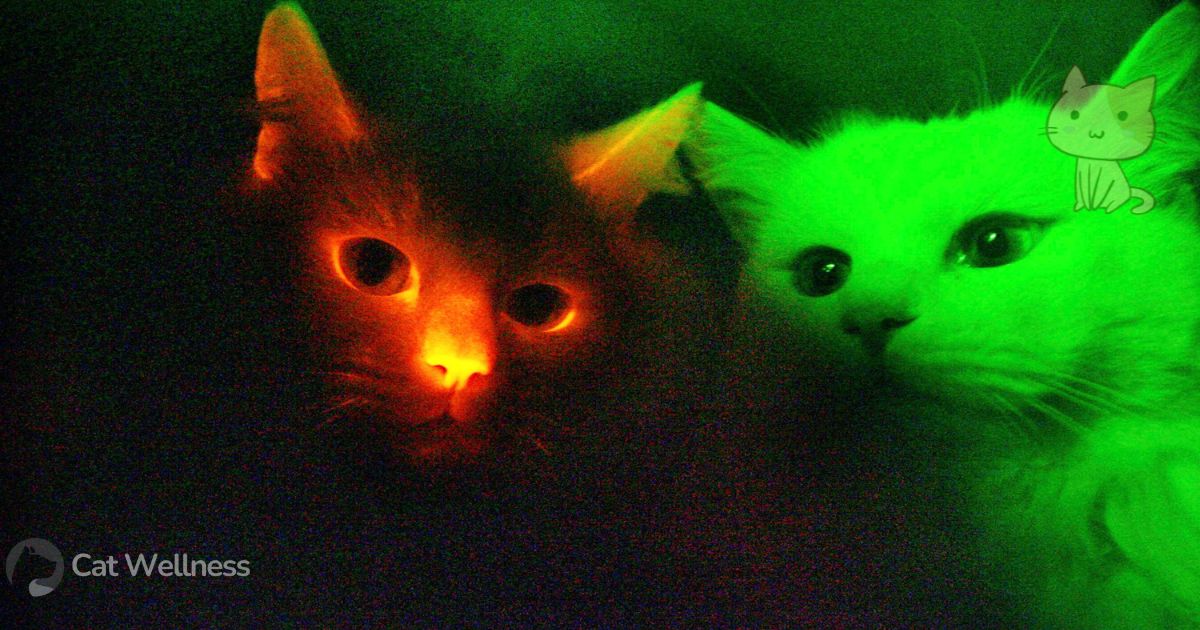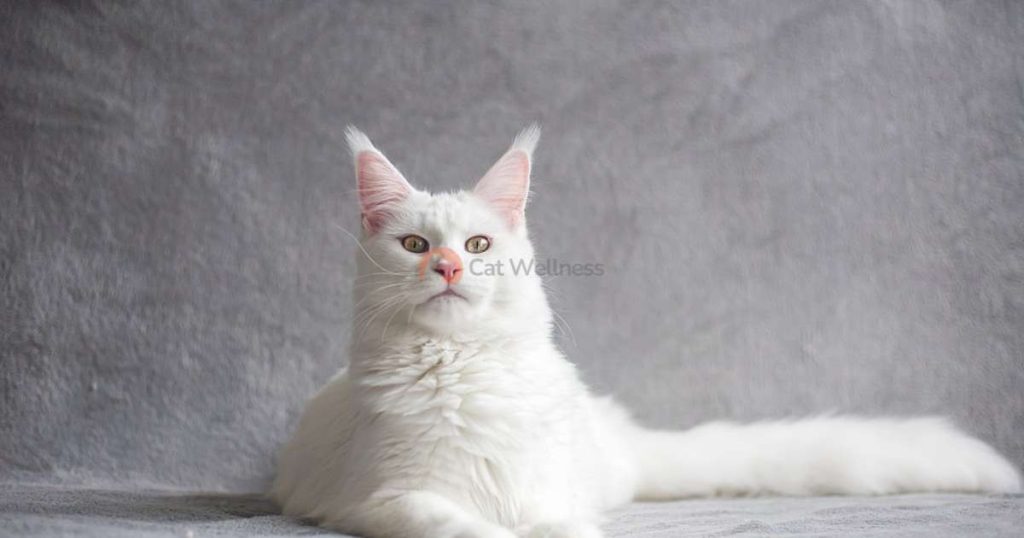The majority of cat owners believe that due to cats’ sensitivity, they can perceive things beyond human capabilities. While there is some truth, it’s important to note that cats cannot detect infrared light.
Even though cats possess excellent night vision and a broader field of view compared to humans, they share the inability to see infrared light. So, can cats see infrared? Keep reading to uncover the explanation.
What Is Infrared Light?

Infrared light constitutes a form of electromagnetic radiation. Similar to other forms of radiation, it arises as atoms absorb and subsequently release energy.
Infrared light is a segment of the electromagnetic spectrum, encompassing high-frequency gamma-rays, X-rays, ultraviolet radiation, visible light, infrared radiation, microwaves, and low-frequency radio waves.
Referred to as infrared radiation, infrared light represents a kind of radiant energy imperceptible to the naked eyes of both cats and humans. Nevertheless, we perceive it as warmth. While all objects in the universe emit some degree of infrared radiation, prominent sources include fire and the sun.
Infrared radiation is one of the three avenues through which heat transfers between objects, the other two being convection and conduction.
Can Cats See Infrared?
No, cats lack the ability to perceive infrared light. While they possess excellent night vision, they do not possess infrared vision. Nonetheless, they do have sensitive heat receptors in their skin, enabling them to locate warm areas for sleeping. Interestingly, many cold-blooded creatures such as amphibians, snakes, insects, frogs, and fish can detect infrared light.
Infrared light, a form of electromagnetic radiation, is not visible to the human eye due to its longer wavelengths compared to visible light. However, it can be detected as heat. For instance, common devices like remote controls utilize infrared light beyond what’s visible.
Under certain artificial conditions, cats might have a limited ability to perceive near-infrared light. Cats also respond to infrared laser pointers by attempting to chase the emitted dot, but this reaction could be more due to the movement rather than the color red, which falls outside their color perception range.
Cold-blooded animals, like specific snake species, can sense infrared radiation, using it to locate their prey.
Prolonged exposure to infrared lights, particularly those close to the microwave spectrum, can elevate the internal temperature of any creature’s eyes, potentially causing harm.
How Cats See Their Surroundings

While cats possess limited color vision and cannot perceive the world in the same colorful way as other creatures, their reality isn’t restricted to mere black and white. So, what exactly is the nature of feline vision?
Nocturnal Creatures
Cats exhibit remarkable prowess in navigating darkness, which explains their preference for twilight activities. They are most active during the night and early morning due to their exceptional night vision.
This heightened ability to see in low light conditions is attributed to the substantial concentration of rod cells in their retinas—up to six to eight times more than what humans possess.
These abundant rod cells grant cats enhanced sensitivity to faint light and movement in the dark, surpassing the capabilities of human eyes.
Limited Color Perception
While cats excel in nocturnal vision, their capacity for color perception is different. Unlike humans, cats do not experience the complete spectrum of colors due to their unique ocular structure.
This distinction arises from the fact that humans possess around ten times more cone cells, specialized for bright light conditions.
This attribute provides humans up to twelve times better motion detection in well-lit environments than cats. Humans are trichromats, having three types of cones that facilitate the perception of a wide array of colors, particularly blue, green, and red.
Visual Acuity Challenges
Beyond color perception, felines also grapple with limitations in visual acuity, which pertains to the sharpness of vision.
Cats lack the requisite ocular muscles to modify the shape of their lenses, contributing to a less precise visual experience than humans.
This characteristic renders cats nearsighted, making it difficult to discern objects at the same distances as humans.
Instead, cats need to be positioned farther away from an object to achieve a clearer view, as items remain blurry until the cat approaches them closely.
Why Cats Pursue Laser Pointers: Unraveling the Feline Fascination

A common experiment among cat owners involves wielding a laser pointer to observe their cats’ enthusiastic pursuit.
Often, felines will energetically chase the laser dot, scaling walls and covering considerable distances. This phenomenon asks: “What’s behind cats’ keen interest in laser pointers?”
Despite not being the most suitable plaything for cats, these domestic predators possess an inherent hunting instinct. This instinct fuels their determination when chasing after elusive targets.
The inability to capture the elusive laser point can trigger notable frustration. Furthermore, avoiding pointing the laser directly into a cat’s eyes is essential, as this can cause harm.
The driving force compelling cats to engage with laser pointers lies in the movement itself. Anything in motion triggers their primal perception of prey, invoking a natural urge to give chase.
While the pursuit is undoubtedly entertaining, providing cats with tangible toys they can catch is advisable, ensuring their playtime remains fulfilling.
Excessive fixation on laser pointers may lead to vexation for cats, ultimately redirecting their built-up frustration elsewhere over time.
While laser beams pose minimal risk, accidental exposure to a cat’s eyes shouldn’t be a concern, though prolonged direct exposure should be avoided.
Cats perceive laser pointers differently than humans due to the disparities in their visual systems. Notably, they don’t register the color red as we do, perceiving it as a subdued shade of yellow or white.
This discrepancy in visual perception is linked to the distinctive way their eyes transmit information to their brains.
FAQs
Which animals can see infrared light?
Infrared radiation possesses greater wavelengths and lower energy levels than visible light, rendering it invisible to the naked human eye.
Nonetheless, certain creatures like mosquitoes, vampire bats, bed bugs, and snake and beetle species can perceive specific segments of the infrared spectrum. Occasionally, humans can indirectly detect infrared energy in the form of heat.
Can cats see in red LED?
In contrast to humans, felines lack cones that can detect red light frequencies. As a result, they’re unable to perceive the color red.
Therefore, when your cat gleefully pursues a laser pointer throughout the home, they’re not observing the light’s color; they’re simply reacting to its swift motions.
Can cats see TV?
Is it possible for cats to watch TV without attempting to pounce and attack the screen? Absolutely.
While some felines get excited by what’s happening on the screen, others are satisfied with observing the action calmly, and some might not show any interest in television whatsoever.
Conclusion
In short, we covered you on the question, can cats see infrared? Despite cats’ ability to see effectively in low light conditions, their visual capabilities and clarity are not on par with those of humans.
To put it differently, the environments cats perceive lack the vibrancy and allure present in the human visual experience. However, this shouldn’t lead to neglecting the importance of monitoring your cat’s eyesight health.
It’s important to assess their vision regularly, as their current vision, although functional, could deteriorate over time, potentially leading to impaired vision or even blindness.
Recommended Reading



























